Stink bugs are often associated with their notorious odor, which they use as a defense mechanism against predators. However, beyond their smelly reputation, many species display striking colors, intricate patterns, and fascinating body structures that make them some of the most visually captivating insects. These beautiful stink bugs can be found across various regions, from the lush rainforests of Southeast Asia to the vast grasslands of Africa. Below is a detailed exploration of the ten most stunning stink bugs in the world, each boasting unique characteristics and ecological significance.
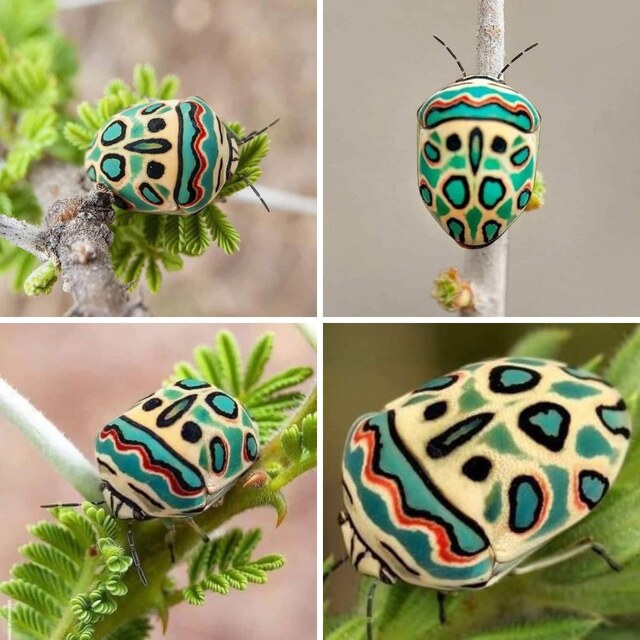
The Picasso bug is often regarded as one of the most visually spectacular stink bugs due to its mesmerizing geometric patterns and vivid coloration. Named after the famous artist Pablo Picasso, this bug features a distinct black and green pattern on its shield-like exoskeleton, resembling abstract artwork. The Picasso bug is native to the tropical regions of Africa, particularly in countries like Kenya, Tanzania, and Uganda, where it thrives in warm, humid environments.
Measuring about 8 mm in length, this small yet striking insect belongs to the Scutelleridae family, also known as jewel bugs. Unlike traditional stink bugs, which tend to have a more matte appearance, the Picasso bug has a glossy, almost metallic sheen that makes it stand out in the wild. This vibrant coloration is not just for show; it serves as an effective form of aposematic (warning) coloration, signaling to predators that it is toxic or unpalatable.
The Picasso bug primarily feeds on plant sap, using its specialized mouthparts to pierce stems and leaves. While not considered a major agricultural pest, it can sometimes be found on crops, feeding on essential plant nutrients. When threatened, like other stink bugs, it releases a foul-smelling chemical to deter predators such as birds and lizards.
Due to its incredible appearance, the Picasso bug has become a favorite subject for macro photographers and insect enthusiasts. Many nature lovers seek it out to capture its intricate patterns in detail. Despite its beauty, it remains a wild insect, best admired in its natural habitat rather than being collected or handled, as its defensive chemicals can be irritating.

The red-bordered stink bug is a visually striking species that features a bold red outline surrounding its dark, shield-shaped body. This contrast makes it one of the most recognizable stink bugs, particularly in Central and South America, where it is commonly found. The bright red border serves as a warning signal to potential predators, indicating that it has chemical defenses that make it an unappetizing meal.
Typically measuring between 12 and 18 mm in length, the red-bordered stink bug belongs to the Pentatomidae family, the largest family of stink bugs. Unlike many other species, this bug has a somewhat flattened body, giving it a distinct shape that helps it blend into its surroundings when resting on tree bark or leaves.
The red-bordered stink bug primarily feeds on plant juices, piercing fruits and stems with its sharp, straw-like mouthparts. It is particularly attracted to leguminous plants such as beans and soy, making it a potential agricultural pest. Farmers in regions where this bug is prevalent often take measures to control its population to prevent crop damage.
Like other stink bugs, it has a well-developed defense mechanism. When disturbed, it can emit a strong, unpleasant odor that lingers in the air, making it difficult for predators to tolerate. Some birds and small mammals, however, have developed a tolerance to these chemicals and occasionally prey on them.
Despite being considered a pest in some areas, the red-bordered stink bug is admired for its striking coloration and unique body structure. In recent years, it has gained attention from insect photographers and researchers studying aposematic coloration in insects.
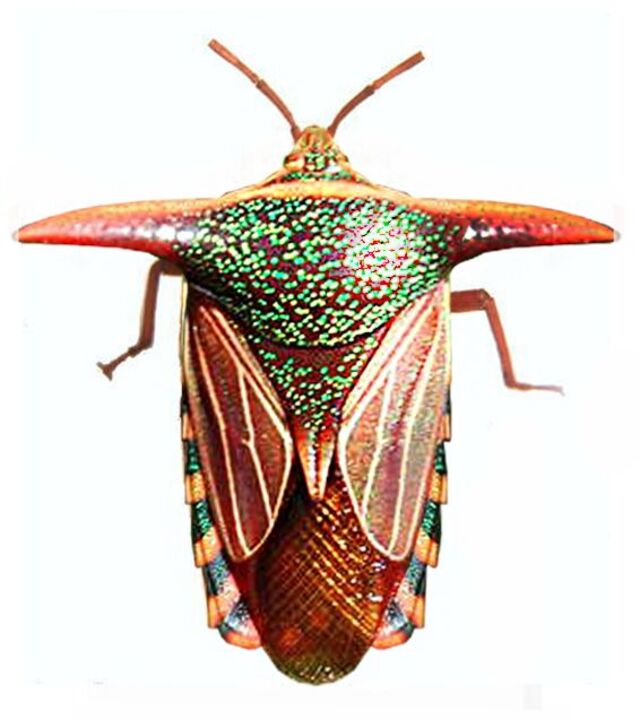
The ornate shield bug is a true gem among stink bugs, displaying a variety of vibrant colors and patterns. Native to Europe, this species exhibits several color morphs, including bright red, orange, yellow, and even white, all featuring bold black markings. This striking appearance makes it one of the most aesthetically appealing members of the stink bug family.
Measuring about 8–12 mm in length, the ornate shield bug is commonly found in meadows, agricultural fields, and gardens. It primarily feeds on cruciferous plants such as cabbage, mustard, and radish, making it a common sight in agricultural landscapes. Because of its feeding habits, it is sometimes considered a minor pest, but its presence is usually not as harmful as other agricultural stink bugs.
One of the fascinating aspects of the ornate shield bug is its seasonal color variation. In colder months, its colors tend to be more muted, while in warmer months, its patterns become more vibrant. This adaptation helps it blend into different environments and avoid predators.
Despite its small size, the ornate shield bug has a powerful defense mechanism. When threatened, it secretes a pungent chemical from its glands, deterring birds, reptiles, and even some insect predators. Researchers have found that these defensive compounds contain aldehydes and ketones, which contribute to the strong, repelling odor.
The ornate shield bug plays an essential role in its ecosystem by participating in plant population control. While it feeds on plants, it also serves as a food source for predatory insects, keeping the balance of the food chain intact. Additionally, its striking coloration makes it a favorite among entomologists and macro photographers who seek to document the diverse beauty of insect life.
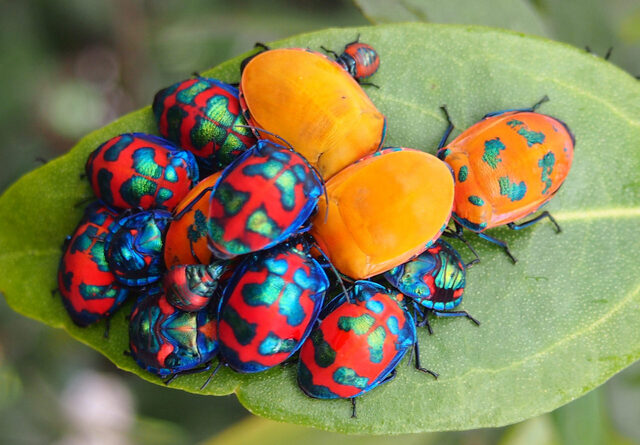
The hibiscus harlequin bug is among the most vibrantly colored stink bugs, displaying an iridescent exoskeleton that shimmers in hues of metallic blue, green, orange, and purple. This species is native to Australia, New Guinea, and parts of Southeast Asia, where it thrives in warm climates with abundant plant life.
Males and females exhibit sexual dimorphism, with males often having more intense metallic colors, while females display a duller, more uniform orange hue. This difference in coloration is believed to play a role in mate selection, as females may choose the most brightly colored males as mates.
Hibiscus harlequin bugs are primarily found on hibiscus plants and other members of the mallow family, where they feed on plant sap. They use their piercing-sucking mouthparts to extract nutrients, sometimes causing visible damage to plants. In some regions, they are considered minor agricultural pests, particularly in gardens and ornamental plant nurseries.
One of the most remarkable aspects of this stink bug is its group behavior. Unlike many solitary stink bugs, the hibiscus harlequin bug often gathers in small groups, particularly during mating seasons. This social behavior is unusual among stink bugs and makes them an interesting species to observe in the wild.
Despite its beauty, the hibiscus harlequin bug retains the classic stink bug defense mechanism. When threatened, it can release a pungent odor that serves as a deterrent to predators. This defense, combined with its stunning appearance, ensures its survival in the wild.
Due to its vibrant colors, this species is frequently photographed by nature enthusiasts and entomologists. It serves as an excellent example of how insects can display remarkable beauty while also having significant ecological roles.
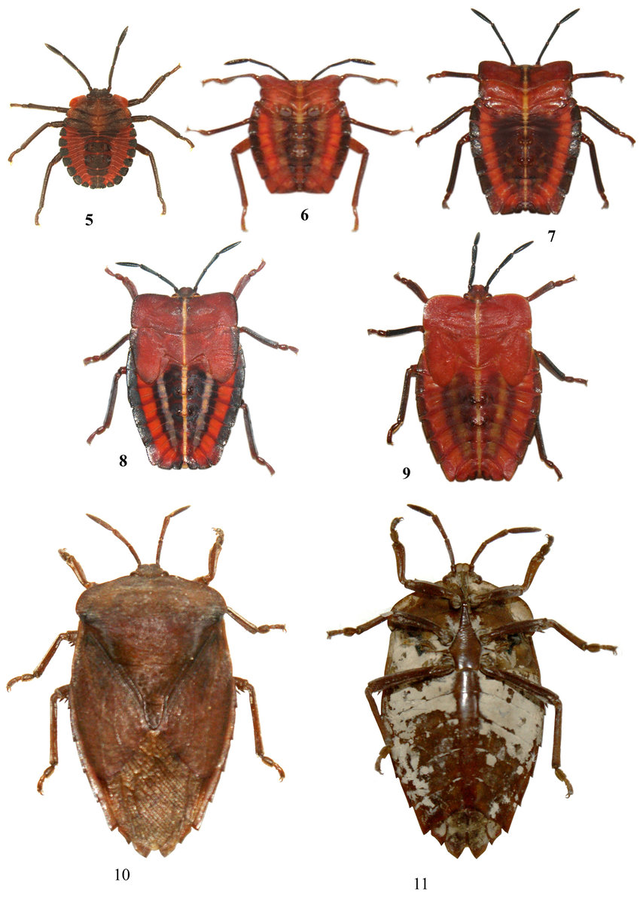
The lychee stink bug, also known as the longan bug, is a large and strikingly colored species found primarily in Southeast Asia, particularly in China, Thailand, Vietnam, and India. It has a reddish-orange or yellowish-brown body, with a broad, shield-shaped exoskeleton that makes it easily recognizable. This bug is one of the most significant agricultural pests in regions where lychee and longan fruits are cultivated, as it feeds on the sap of these plants, causing fruit deformities and yield losses.
Adults of this species can grow up to 30 mm in length, making them one of the larger stink bug species. They have strong, well-developed piercing-sucking mouthparts that allow them to extract plant juices efficiently. When feeding, they inject toxic saliva into plant tissues, leading to wilting, discoloration, and fruit drop. This feeding behavior not only damages crops but also reduces fruit quality, making it a major concern for farmers.
Despite its status as a pest, the lychee stink bug is visually impressive. Its bright coloration serves as a warning signal to predators, deterring birds and other potential threats. When disturbed, it releases a strong-smelling defensive chemical, which is particularly potent compared to many other stink bug species.
The lychee stink bug undergoes five nymphal stages before reaching adulthood, with each stage showing slight variations in coloration and pattern. Nymphs are often more vibrantly colored than adults, displaying shades of red and orange with black markings. These young bugs tend to stay in groups, increasing their chances of survival through collective chemical defense mechanisms.
Due to its impact on agriculture, researchers have been studying ways to manage this species through biological control methods, such as introducing natural predators like parasitic wasps. Farmers also use pheromone traps and insecticidal sprays to reduce infestations. Despite its destructive nature, the lychee stink bug remains an important species for ecological research, particularly in studies of insect-plant interactions and chemical defense strategies.
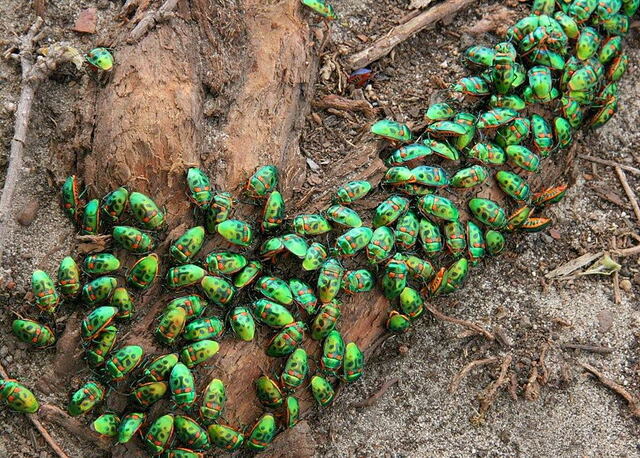
Jewel bugs, often mistaken for beetles due to their hard, glossy exoskeletons, are some of the most visually stunning stink bugs. They belong to the Scutelleridae family, closely related to true stink bugs (Pentatomidae), and are known for their iridescent, metallic colors that range from emerald green and sapphire blue to gold and copper. Their shimmering exoskeletons reflect light in a way that makes them appear almost gem-like, earning them their name.
Jewel bugs are found in tropical and subtropical regions worldwide, with many species occurring in Asia, Africa, and Australia. They are commonly seen resting on leaves or tree trunks, where their striking colors serve as both camouflage and warning signals to predators. Their vibrant hues are an example of structural coloration, where microscopic surface structures refract light to produce brilliant colors rather than relying on pigmentation alone.
Most jewel bugs feed on plant sap, using their needle-like mouthparts to pierce leaves, stems, and seeds. Unlike some other stink bugs, they rarely cause significant damage to crops, making them less of a concern for farmers. However, a few species are known to feed on economically important plants, leading to localized infestations.
One of the fascinating aspects of jewel bugs is their ability to produce defensive chemicals that deter predators. Their exoskeletons are not just visually appealing but also serve as a protective shield, making them more resistant to attacks. When threatened, they release a foul-smelling secretion that discourages birds, lizards, and other predators from eating them.
Due to their incredible beauty, jewel bugs are popular among insect collectors and photographers. Many species are studied for their unique coloration mechanisms, which could inspire advancements in biomimetic materials and optical technology. Their presence in ecosystems also contributes to biodiversity, playing roles in plant population control and serving as food for specialized predators.
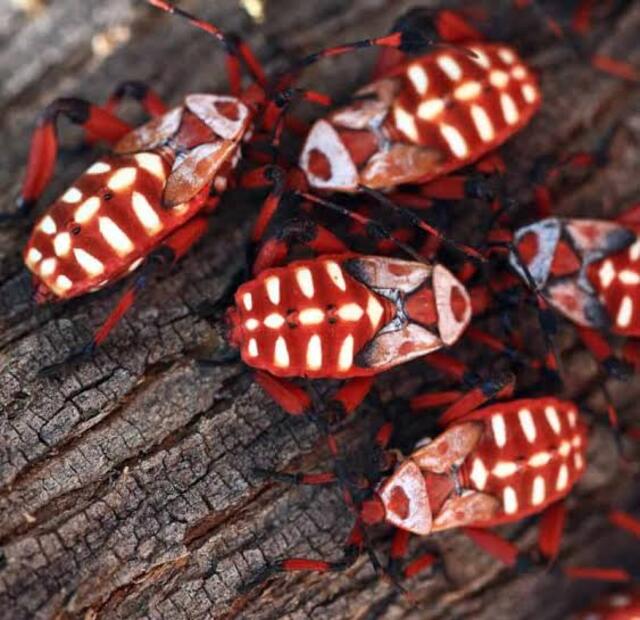
The giant mesquite bug is one of the largest and most eye-catching stink bugs, growing up to 30 mm in length. It is native to North and Central America, particularly in arid and semi-arid regions where mesquite trees thrive. This species is known for its striking red and black coloration, often with intricate yellow markings that add to its visual appeal.
Unlike many other stink bugs that prefer solitary lifestyles, giant mesquite bugs are highly gregarious, especially during their nymphal stages. They are often seen clustered together on tree branches, feeding collectively on mesquite sap. Their bright red and black coloration serves as an aposematic signal, warning predators that they are chemically defended and not suitable for consumption.
One of the most fascinating features of the giant mesquite bug is its seasonal appearance. Adults emerge during the warmer months, typically from late spring to early summer, when mesquite trees are in full bloom. During this time, they mate and lay eggs, ensuring the next generation continues their life cycle.
These bugs, despite their intimidating size, are not considered major agricultural pests. While they feed on mesquite trees, they rarely cause significant damage. In fact, they play a role in nutrient cycling, as their feeding activities help decompose plant material and recycle nutrients back into the soil.
When threatened, giant mesquite bugs can release a strong-smelling defensive chemical, much like other stink bugs. However, their primary defense mechanism is their coloration, which effectively deters most predators. Some birds and lizards, however, have adapted to tolerate their chemical defenses and occasionally prey on them.
For insect enthusiasts and photographers, the giant mesquite bug is a fascinating subject due to its impressive size and vibrant colors. It serves as an excellent example of how insects use visual signals and chemical defenses to survive in their natural habitats.

The clown stink bug is a truly unique species, named for its striking resemblance to a clown’s face due to its bright yellow body and large black-ringed spots. Found in Southeast Asia, this stink bug is particularly abundant in tropical forests, where it feeds on a variety of plants.
This species is relatively large compared to other stink bugs, often reaching around 15–20 mm in length. Its shield-shaped body, combined with its distinctive markings, makes it one of the most easily recognizable stink bugs. The black rings on its back mimic large eyes, potentially confusing predators into thinking it is a much larger creature than it actually is.
Like most stink bugs, the clown stink bug is herbivorous, feeding on plant sap. It is commonly found on fruiting trees, shrubs, and ornamental plants. While it does not pose a serious threat to crops, it can occasionally be found in agricultural areas, where its feeding may cause minor damage to fruits and leaves.
This stink bug’s coloration and markings are a prime example of Batesian mimicry, where an organism evolves to resemble a more dangerous or toxic species. Predators that encounter the clown stink bug may mistake it for a toxic species and avoid attacking it.
When threatened, the clown stink bug releases a potent, foul-smelling odor from its scent glands. This defensive mechanism is highly effective against birds, lizards, and other insectivorous predators.
Due to its fascinating appearance, the clown stink bug is frequently studied by entomologists interested in insect mimicry and defensive strategies. It is also a popular subject for insect photographers who seek to capture its striking patterns in detail.
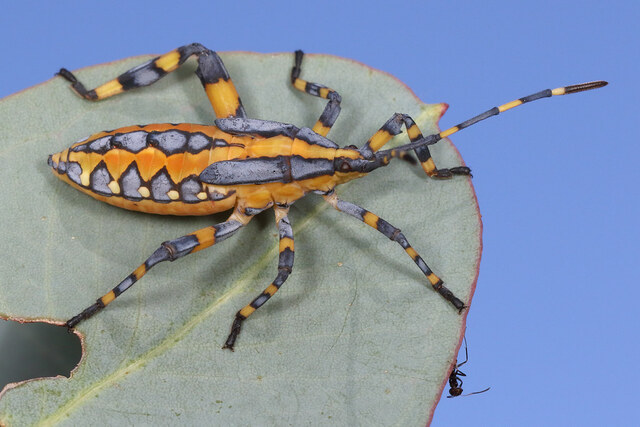
The eucalyptus stink bug is a beautifully colored species native to Australia, where it primarily feeds on eucalyptus trees. Unlike many stink bugs that display bold warning colors, this species is known for its shimmering, metallic green and copper exoskeleton, which allows it to blend seamlessly with the leaves of its host plants. This natural camouflage helps protect it from predators while also adding to its visual appeal.
Measuring around 10–15 mm in length, the eucalyptus stink bug belongs to the Pentatomidae family. It has a classic shield-shaped body with smooth, reflective surfaces that give it a polished appearance. The color of its exoskeleton can change slightly depending on the angle of light, creating an iridescent effect similar to that seen in jewel bugs (Scutelleridae). This structural coloration, rather than pigmentation, is what gives the bug its unique metallic sheen.
The eucalyptus stink bug primarily feeds on the sap of eucalyptus leaves and young shoots. Using its piercing-sucking mouthparts, it extracts nutrients from plant tissues, which can sometimes cause minor leaf discoloration or curling. However, unlike other agricultural stink bugs, it does not pose a significant threat to its host trees. In some cases, populations may increase during warm seasons, but they are generally kept in check by natural predators such as birds and parasitic wasps.
As a defense mechanism, the eucalyptus stink bug, like other members of its family, produces a strong-smelling chemical secretion when threatened. This odor deters predators and helps ensure its survival. Interestingly, its natural habitat in eucalyptus forests provides an additional layer of protection, as the strong aroma of eucalyptus trees can mask the bug’s scent, making it harder for predators to detect.
Entomologists and insect enthusiasts are particularly fascinated by this species due to its remarkable coloration and ecological adaptations. Its ability to blend into its environment while still displaying a visually stunning exoskeleton makes it one of the most beautiful stink bugs in the world. Additionally, researchers studying insect camouflage and structural coloration often use the eucalyptus stink bug as a model species for their studies.
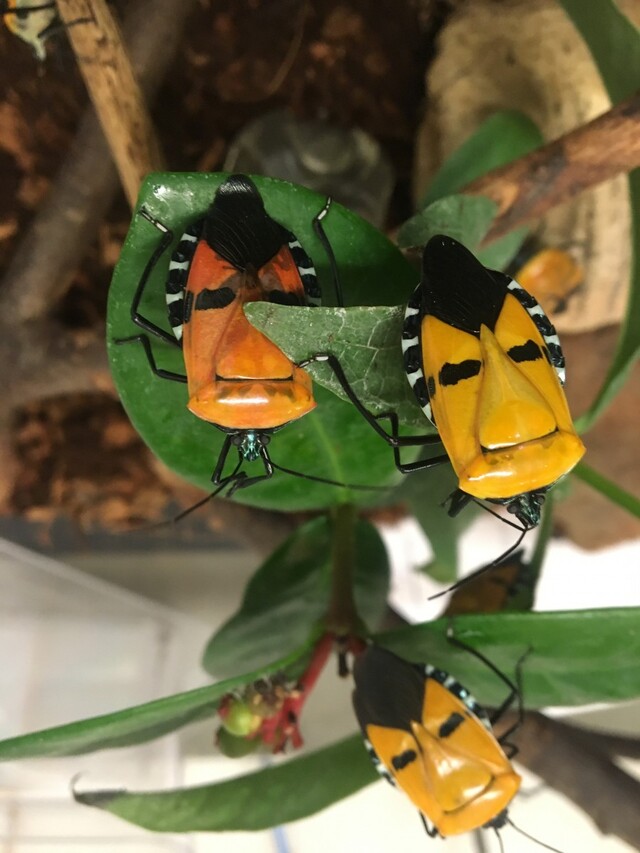
One of the most peculiar and visually striking stink bugs in the world, the man-faced stink bug (Catacanthus incarnatus) has gained fame for the eerie human-like face pattern on its back. Native to South and Southeast Asia, including India, Sri Lanka, Thailand, and Malaysia, this species is known for its large size, vibrant coloration, and unusual markings that resemble a stylized face.
This stink bug typically measures between 15–25 mm in length and comes in several color variations, including red, yellow, orange, and sometimes even purple. The most defining feature of this bug is the pair of large, dark circular markings on its back, which look like "eyes," along with additional patterns that create the illusion of a nose and mouth. This phenomenon, known as automimicry or self-mimicry, is believed to help deter predators by making the bug appear as a larger, more intimidating creature.
Like other stink bugs, the man-faced stink bug is herbivorous, feeding on plant sap from a variety of trees and shrubs. It uses its specialized mouthparts to pierce plant tissues and extract nutrients. While not considered a major agricultural pest, it is sometimes found in gardens, orchards, and forests where its host plants are abundant.
When disturbed, the man-faced stink bug releases a pungent defensive secretion from its thoracic glands, discouraging potential threats such as birds and small mammals. The strength of this chemical deterrent makes it unpalatable to most predators, ensuring its survival despite its conspicuous appearance.
In recent years, this species has gained significant attention among insect collectors, photographers, and researchers. The strange "face" on its back has led to various cultural interpretations, with some people considering it a symbol of good luck, while others see it as a curiosity of nature. Scientists studying aposematic (warning) coloration and mimicry in insects have also taken an interest in this bug, as it provides a fascinating example of how visual deception can be an effective survival strategy.
Due to its striking appearance and unique defensive adaptations, the man-faced stink bug is one of the most photographed and talked-about stink bugs in the world. Whether seen as a work of natural art or an evolutionary marvel, this species is undoubtedly one of the most beautiful and intriguing members of the stink bug family.
While stink bugs are often dismissed due to their unpleasant odor, these ten species prove that they can also be some of the most visually stunning insects in the world. From the intricate geometric patterns of the Picasso bug to the iridescent shimmer of the jewel bug and the bizarre facial illusion of the man-faced stink bug, these insects showcase nature’s incredible diversity and creativity.
Each of these stink bugs plays a crucial role in their ecosystems, whether as plant feeders, prey for predators, or subjects of scientific research. Their vibrant colors and unique markings serve not only as eye-catching displays but also as essential survival adaptations. As more people become interested in insect photography and biodiversity conservation, these beautiful stink bugs continue to capture the fascination of nature lovers worldwide.
Whether you’re an entomologist, a photographer, or simply an admirer of nature’s beauty, these stunning stink bugs remind us that even the smallest creatures can be masterpieces of evolution.
animal tags:
We created this article in conjunction with AI technology, then made sure it was fact-checked and edited by a Animals Top editor.